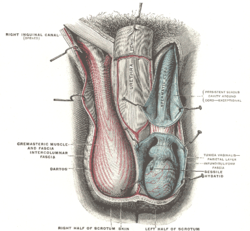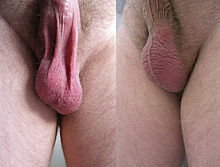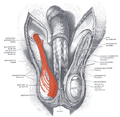- Cremaster muscle
-
Cremaster muscle The cremaster muscle appears as a thin layer just superficial to the tunica vaginalis. Latin musculus cremaster Gray's subject #118 414 Origin Inguinal ligament Insertion Tunica vaginalis Artery Cremasteric artery Nerve Genital branch of genitofemoral nerve Actions raise and lower the scrotum The cremaster muscle is a muscle that covers the testis.
Contents
Contraction
Its function is to raise and lower the testes in order to regulate the temperature of the testes and promote spermatogenesis. Contraction may also occur during arousal which can prevent injury to the testicles during sex.[citation needed]
In a cool environment the cremaster draws the testis closer to the body and reduces surface area thereby reducing heat loss, while when it is warmer the cremaster relaxes allowing the testis to cool by increasing exposed surface area.[citation needed]
Contraction can also occur during moments of extreme fear, possibly to help avoid injuring the testes while dealing with a fight or flight situation.[citation needed]
Clinically, a reflex arc termed the cremasteric reflex can be demonstrated by lightly stroking the skin of the inner thigh downwards from the hip towards the knee. This causes the cremaster muscle on the same side to rapidly contract, raising that testicle.[citation needed]
The cremaster can also be contracted voluntarily, by contracting the pubococcygeus muscle (using Kegels), or by sucking in the abdomen.[citation needed]
Development and sex differences
The cremaster develops to its full extent only in males; in females it is represented by only a few muscle loops.
In human females, the cremaster muscle is smaller and is found on the round ligament.
In rats, it has been shown that cremaster muscles developed from the gubernacular bulb.
Structure
In human males, the cremaster muscle is a thin layer of skeletal muscle found in the inguinal canal and scrotum between the external and internal layers of spermatic fascia, surrounding the testis and spermatic cord. The cremaster muscle is a paired structure, there being one on each side of the body.
Anatomically, the lateral cremaster muscle originates from the internal oblique muscle, just superior to the inguinal canal, and the middle of the inguinal ligament. The medial cremaster muscle, which sometimes is absent, originates from the pubic tubercle and sometimes the lateral pubic crest. Both insert into the tunica vaginalis underneath the testis.
Innervation and vascular supply
The cremaster muscle is innervated from the genital branch of the genitofemoral nerve and supplied by the cremasteric artery.
It receives distinctly different innervation and vascular supply in comparison to the internal oblique.
Etymology
The word is derived from the Greek verb κρεμάννυμι = "I hang (transitive)", not from Latin cremare.
Additional images
External links
- -731185075 at GPnotebook
- LUC crem
- SUNY Labs 36:07-0102 - "Inguinal Region, Scrotum and Testes: Layers of the Spermatic Cord"
- Cremaster+muscle at eMedicine Dictionary
List of muscles of abdominopelvic cavity (TA A04.5, GA 4.408) Abdomen/
wallAnterior/
lateralMuscleFasciaFascia/abdominal fascia: panniculus adiposus (Fascia of Camper) · stratum membranosum (Fascia of Scarpa) · Transversalis fascia (Interfoveolar ligament)
Linea alba · Linea semilunaris · Inguinal triangle
Inguinal canal (Deep inguinal ring, Superficial inguinal ring, Intercrural fibers, Crura of superficial inguinal ring)
Inguinal ligament (Pectineal ligament, Lacunar ligament, Reflected ligament)PosteriorMuscleFasciaPelvis MuscleFasciafascia/pelvic fascia visceral (Rectovaginal fascia, Rectoprostatic fascia) · parietal (Obturator fascia/Tendinous arch, Piriformis fascia)
floor/diaphragm: Superior fascia of pelvic diaphragm (Pubovesical ligament, Puboprostatic ligament) · Inferior fascia of pelvic diaphragm
Anococcygeal bodyCategories:- Muscles of the torso
- Male reproductive system
Wikimedia Foundation. 2010.




